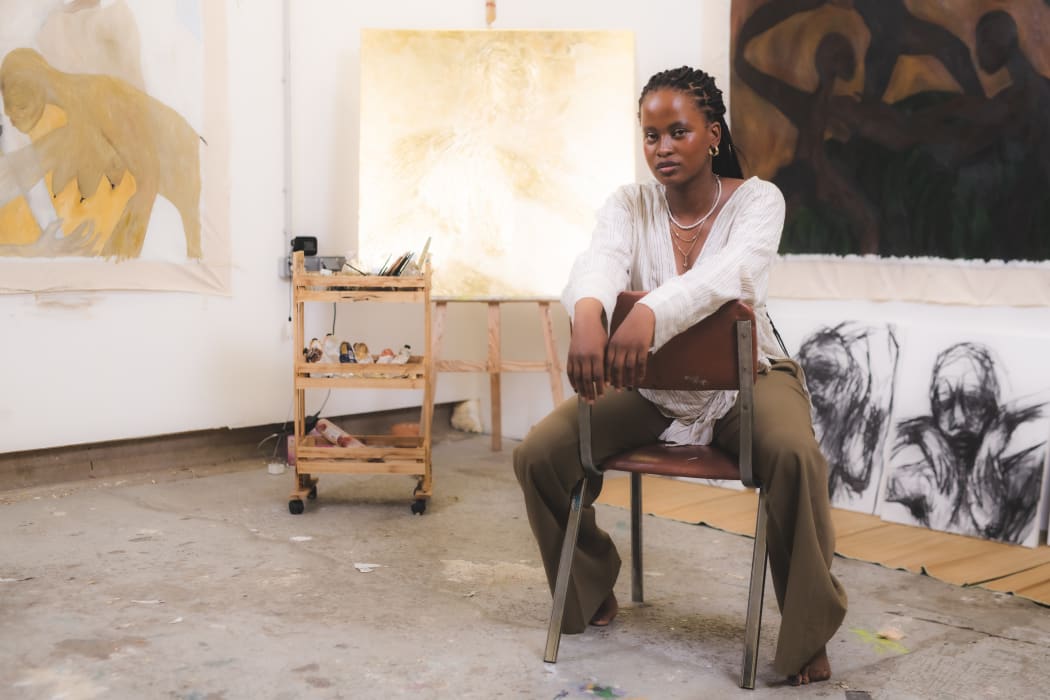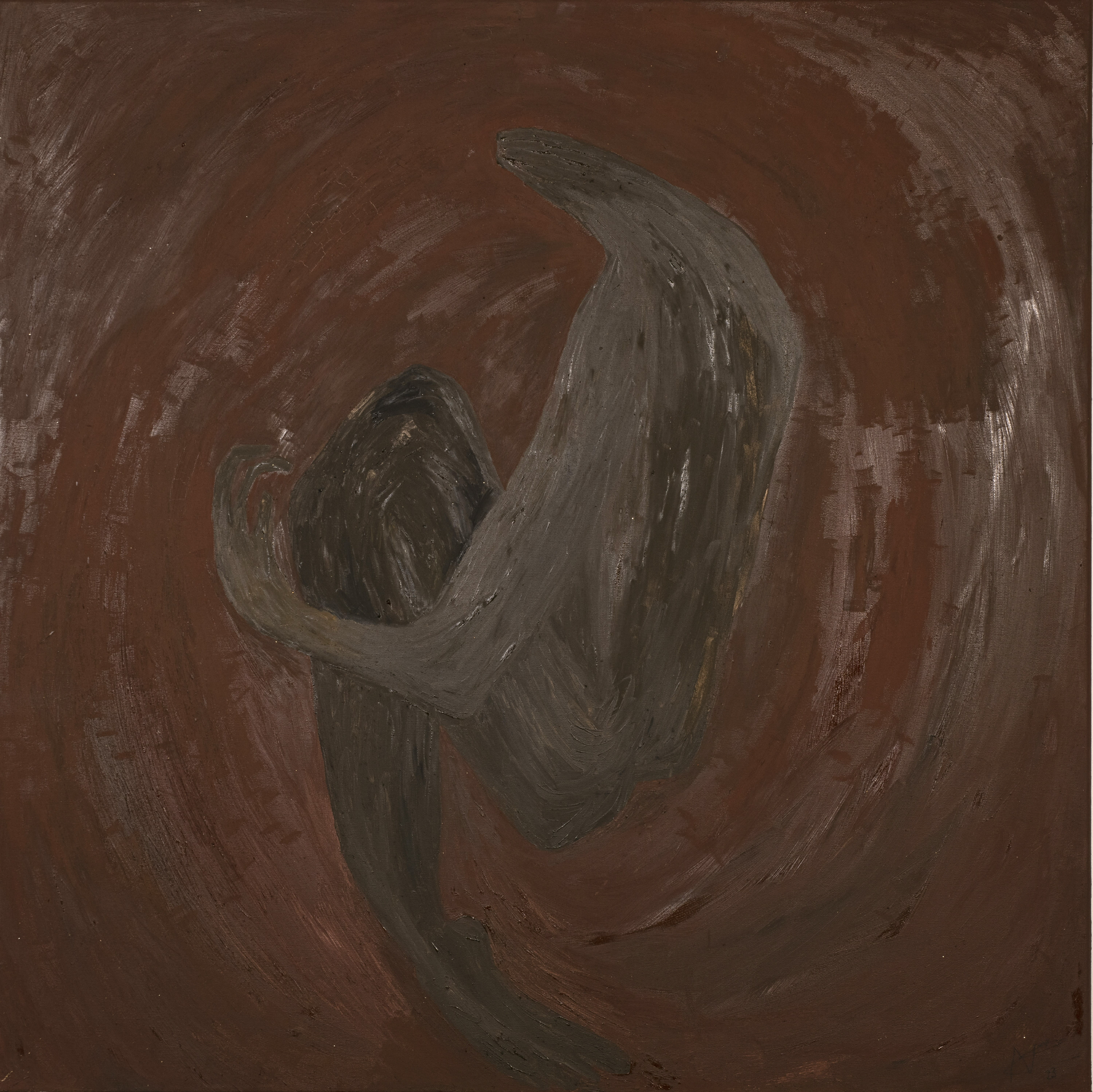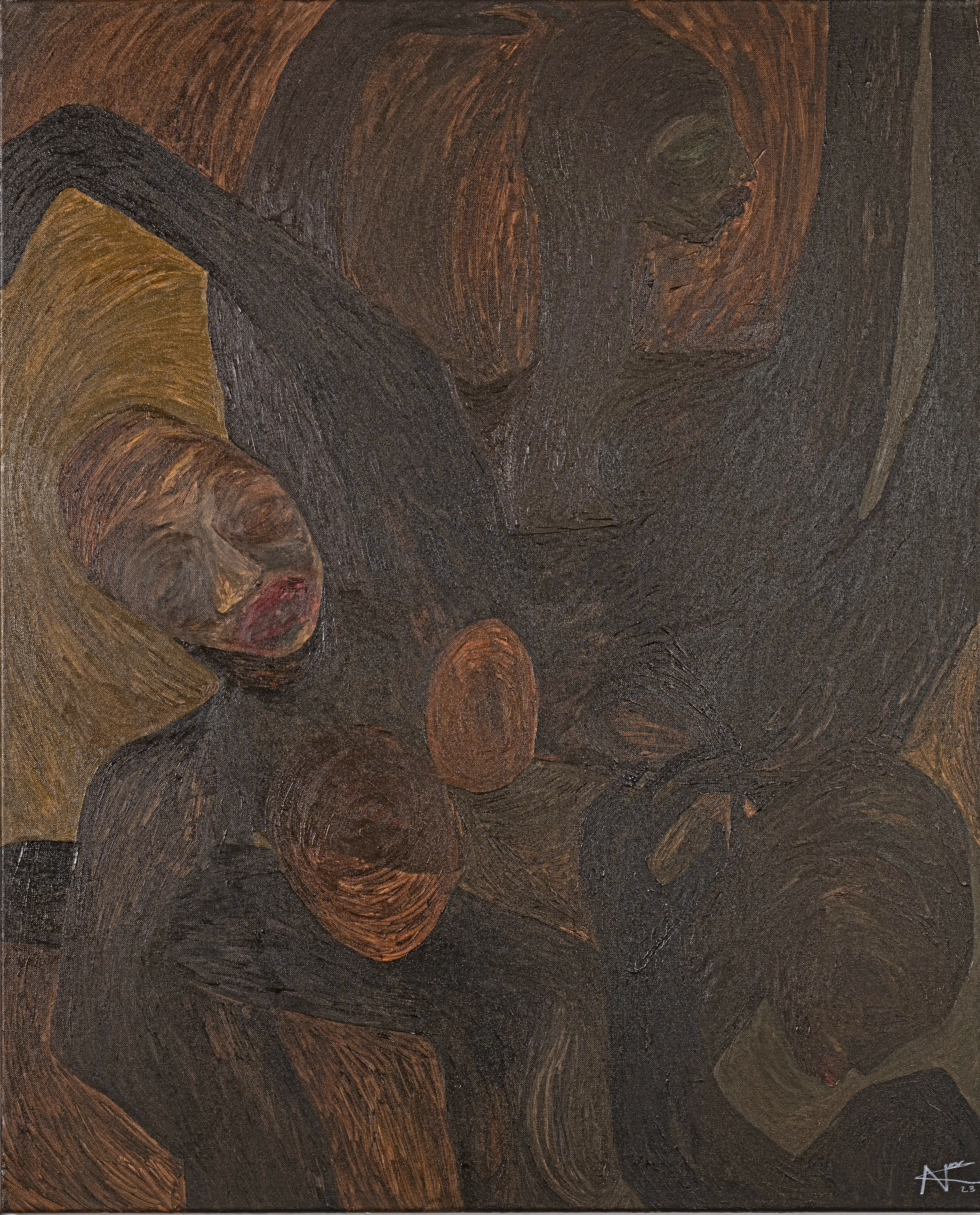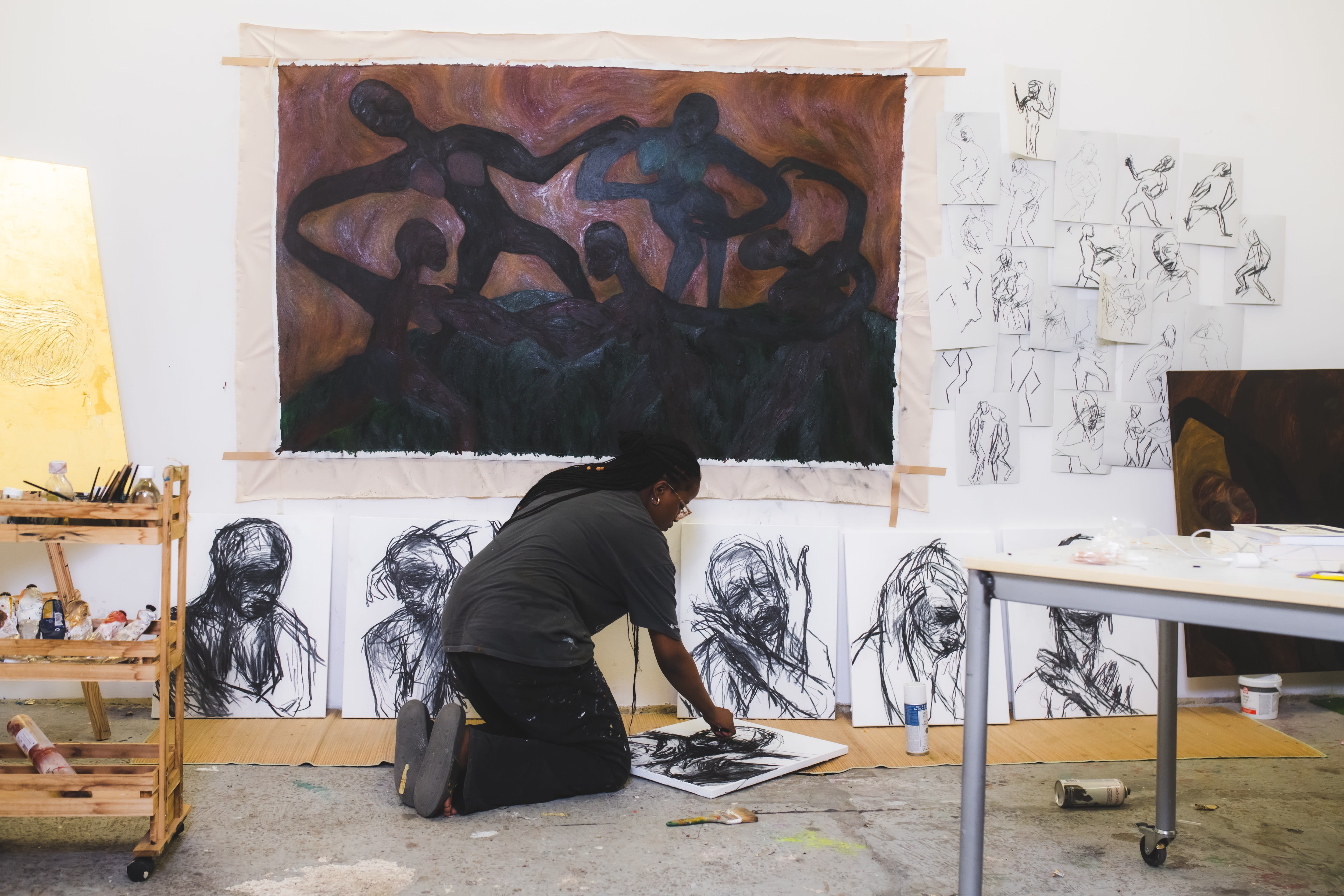
Cradling a candle and matches, Kekana steps through air thick with Thandiswa Mazwai chanting Thongo Lam. She kneels in a corner of the room, flicks the match aflame, and sets the flame over the candle. The flickering light, steady on the floor, illuminates more than what the eye can see. Kekana sits with it, listening. This practice of prayer has been the hallmark of her time at the Makwande Art Residency in Nice. She ends her first studio experience in full circle - with good company. The certainty in her identity as an artist and the depth of her offering in her latest collection - Di Thapelo Tsa Barapedi - cast a long shadow over the Alexandra artist who landed here 6 weeks ago.
Born in Johannesburg, and raised by a protective single mother, her landing in France thrust her into dazzling unfamiliarity. Kekana describes feeling – Black, something she’d never had to consider as a native in her own country.
Her first 2 weeks were charged with such a sense of otherness in skin colour, language, and navigation. Her culture shock and disorientation needed to be given room to breathe instead of being swallowed whole with a gulp of gratitude. In choosing to not betray herself, Kekana allowed the discomfort of her early days in residency to cast her into a cocoon. Novel experiences, no matter how opportune, can be jarring. It takes courage to realise this and give ourselves the space we need to adjust in order to show up authentically.
 This process birthed her first piece – THE BUD SLOWLY OPENS. ‘This piece symbolises my state in the first quarter of the residency. The foetal position depicts the vulnerability and nakedness that comes with growing in new soil. I had to adjust to new people and learn to communicate even when I feared being misunderstood.’
This process birthed her first piece – THE BUD SLOWLY OPENS. ‘This piece symbolises my state in the first quarter of the residency. The foetal position depicts the vulnerability and nakedness that comes with growing in new soil. I had to adjust to new people and learn to communicate even when I feared being misunderstood.’
The fog of otherness soon dissipated in the heat and kindness of the Mediterranean summer. The lucidity allowed a stream of inspiration and a surrender to Spirit. She began to narrate her experience of the people and places she encountered, finding threads of inherent human dignity. ‘I Became a vessel to receive and consume everything around me. That’s when my next piece THE BUD BLOOMS developed. It opened a flow in my process and the pieces that followed came with so much ease.' THE BUD BLOOMS is acrylic and canvas perfection. It bears Kekana’s signature markings of circular strokes and deep hues. Her ability to create contrast within a singular colour, stretching it for tints and tones is ingenious. The figures are postured in a manner that keeps their positional integrity no matter the angle or rotation of the piece. 
Her comfort with solitude and meditation is her channel into intuition. She describes silence as prayer when you don’t know what to say, communicating with herself, God, her ancestors. In this series, the renowned sentinel figures lack eyes, a choice she made after meeting the words – ‘the eyes are useless when the mind is blind’. Contemplative living is what elevates Kekana above her peers at such an early stage of her career.
Her arrival in France was a long-awaited manifestation of what she’s always believed about her talent and what her mother has always hoped for. A wide river of femininity runs through the collection, watering works such as ODE TO SARAH and BLACK MADONNA. The current of her mother’s love and unwavering support is a recurring theme in Kekana’s life and works. Being raised by a single mother is not unique to her, 18 million South African households are headed by single women. Despite the need for a more ‘secure’ career, her mother has remained the steady flow of encouragement upon which Kekana’s vessel sails into the international art scene. In a township notorious for entrenched inequalities and social ills, creating masterpieces in a 20-square-meter bedroom is a triumph. A triumph she cannot claim without honouring her mother and the Divine Feminine that has always guided her.

Ode to Sarah
Kekana is the third and youngest recipient of the Makwande Art Residency. Her selection follows a relationship fostered with residency founder Nomaza Nongqunga Coupez.
The residency not only selects for talent but for artists who show the disciplined markings of an invested commercial creative. The residency afforded her a private studio space for the first time in her practice, a far cry from painting from her bedroom. Acquired in partnership with LaStation, the collective art space allowed her to create in community with others. With more space and the curation of various gallery and museum visits, she emerges fully fledged, producing works on a scale not seen before.

Nomaza & Nthabiseng in her studio at LaStation in Nice during the Makwande Art Residency
Kekana is an impressionist of Spirit. Where Monet could hold the same subject to different lighting and moments; she holds Spirit to different manifestations, painting atmosphere, painting another realm into our world. Between the opulence of pastel curated buildings, the unsettling homelessness, gleeful tourists, the nocturnal emergence of the native residents… a spectrum of human condition threads her experience of Nice.

Self by Nthabiseng Boledi Kekana
The long axis of the studio wall and floor supports a series of portraits titled – Self. ‘I was the muse behind these works. I was working hard and giving every waking minute to my work. With limited time and a tight schedule for research, I was feeling rather overwhelmed despite support from Nomaza and my mother. I stopped creating and deciding to feel what I was feeling. I took pictures of myself in these raw poses and emotions, I didn’t try to dim down what I was feeling at the time.’ She immediately worked out the emotions with charcoal and canvas and a series of shear emotive translucency emerged. Brene Brown explains that ‘Vulnerability is life’s great dare…. Often the result of daring greatly isn’t a victory march as much as it is a quiet sense of freedom mixed with a little battle fatigue’.

Pata-Pata by Nthabiseng Boledi Kekana
A 200cm/100cm piece takes centre stage on the long wall of the studio - a multifigure painting of deep oil and oil sticks on canvas. The still movement draws you in and calls for your own rhythm. The piece bears its conceptual origins from Martisse’s - The Dance, and Mariam Makeba’s - Pata-Pata. This closing piece pays homage to Kekana's transcontinental influences, the celebratory arch of her residency. The figures, holding space for themselves while holding each other in joy convey the heart of - ‘Pata-pata is the name of a dance we do down in Johannesburg way, everybody starts to move as soon as Pata-pata starts to play.’
Miriam Makeba beams through the studio, we dance among oiled masteries, celebrating Kekana's incredible journey and sure future. She blows out the candle in gratitude, gracefully closing her residency.

Dzunisani Ngobeni during her interview with Nthabiseng Boledi Kakana in her studio during the Makwande Art Residency
References
The eyes are useless when the mind is blind - Mark Venturini
Statista. (n.d.). South Africa: number of female-headed households, by province. [online] Available at: https://www.statista.com/statistics/1363435/number-of-female-headed-households-in-south-africa-by-province/#:~:text=Number%20of%20female%2Dheaded%20households%20in%20South%20Africa%202021%2C%20by%20province&text=In%202021%2C%20around%207.6%20million [Accessed 5 Sep. 2023].
Brown, B. (2012). Daring Greatly: How the Courage to Be Vulnerable Transforms the Way We Live, Love, Parent, and Lead. London: Penguin Books Ltd.

